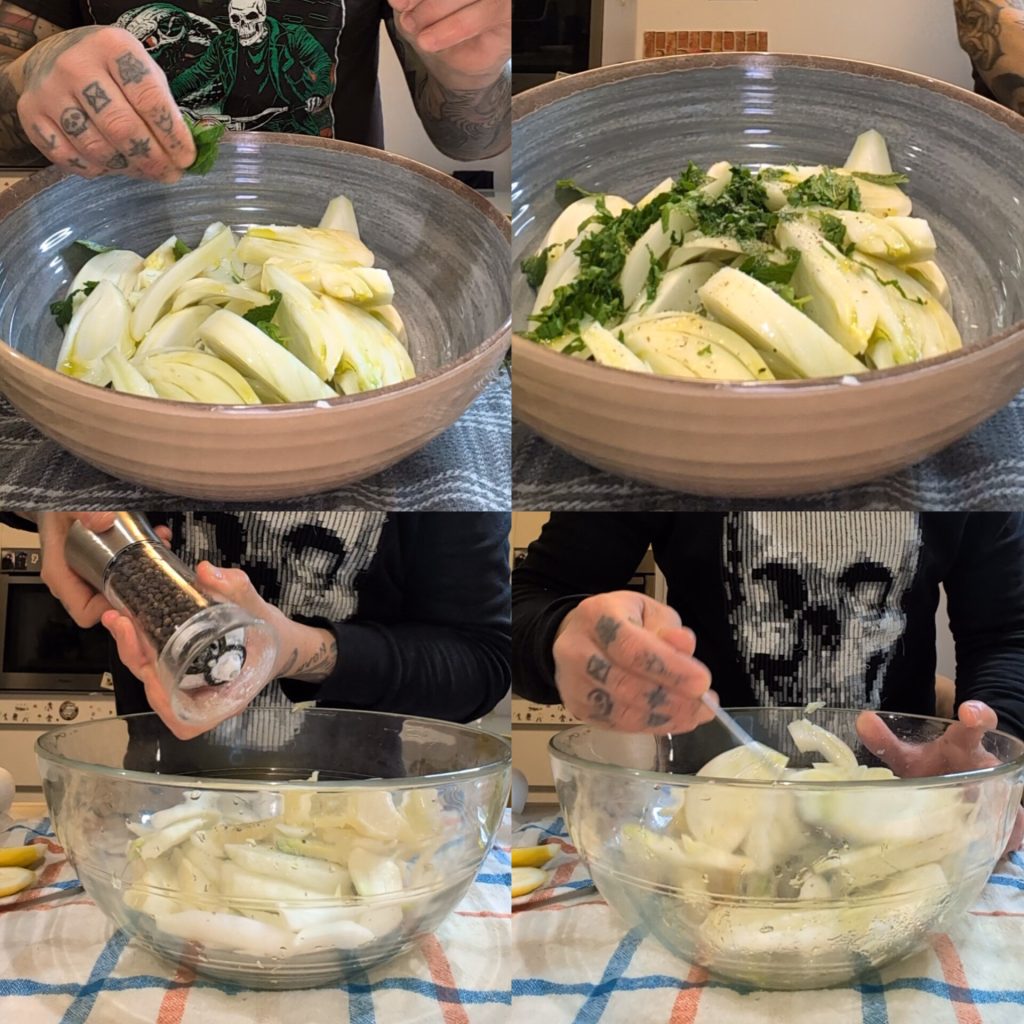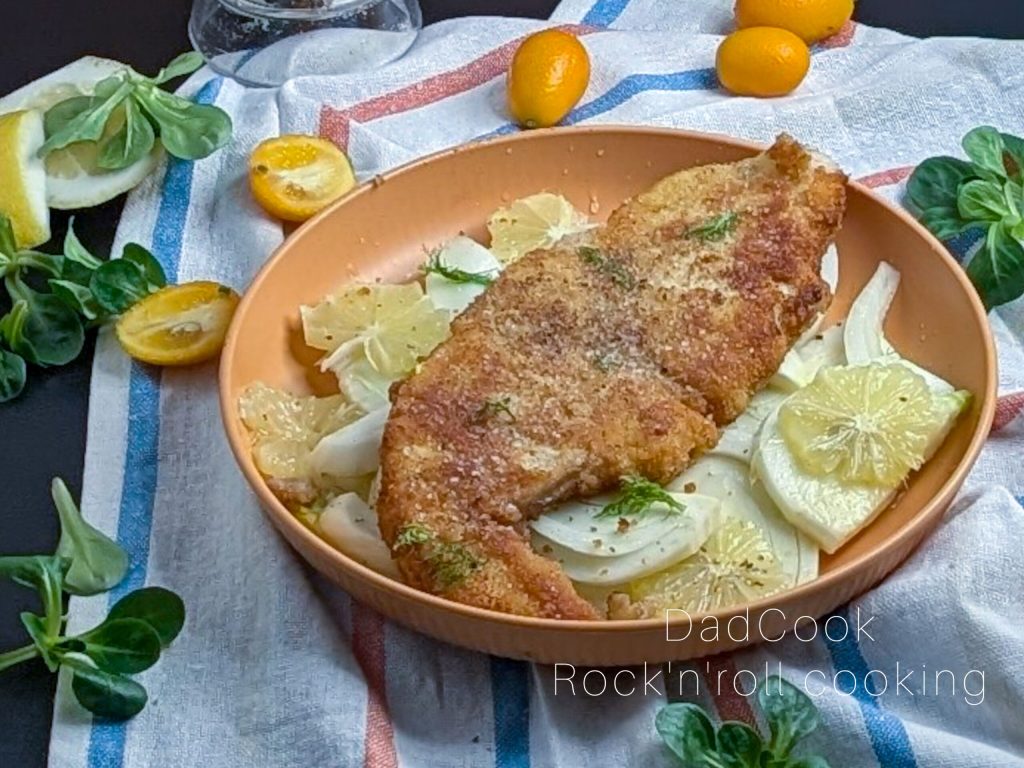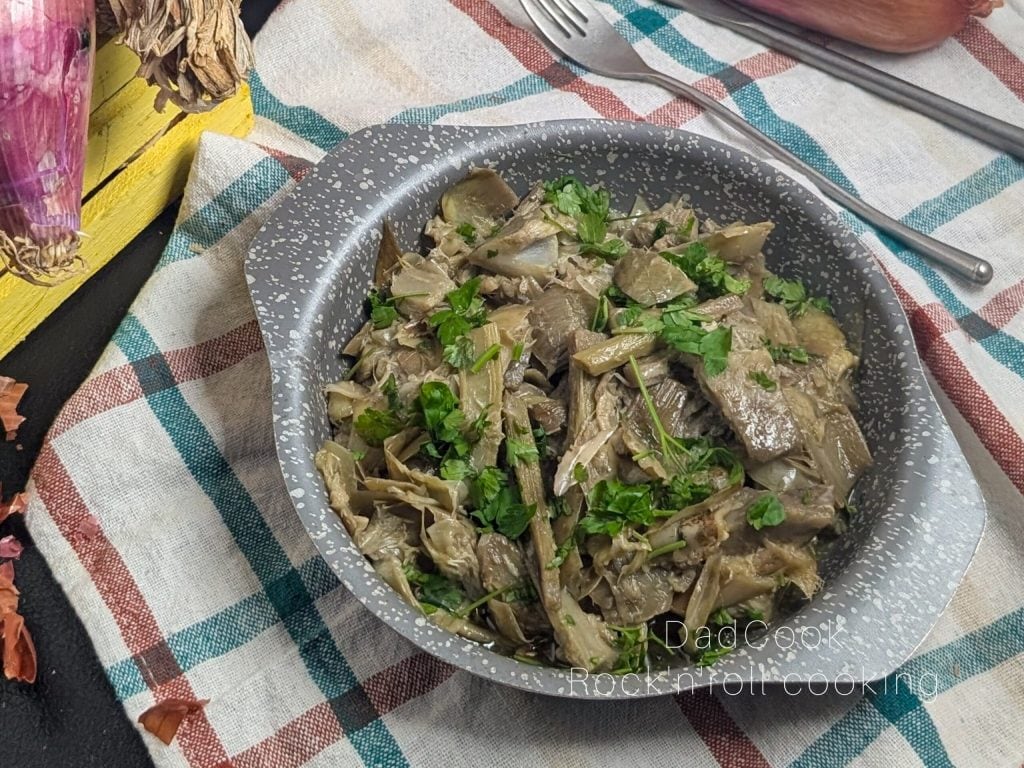Imagine: the golden crunchiness of the classic Milanese cutlet, but with a tender and flavorful heart of fresh swordfish.
An unexpected encounter between Lombard tradition, keeper of ancient and genuine flavors, and the scent of the sea, bringing with it the breeze and freshness of the waves.
A surprising combination that creates a dish capable of conquering all palates, from the youngest, always in search of new and fun flavors, to the oldest, who will appreciate the refinement of this reinterpretation.
Get ready to discover a new version of the cutlet, far from the heaviness of meat, yet equally satisfying.
A light and tasty recipe, perfect for a joyful family lunch or a delightful dinner with friends, where you can impress with a touch of originality.
A dish that lends itself to a thousand occasions, from a summer table in the garden to a more formal Sunday lunch.
And don’t be deceived by its apparent complexity: this recipe is truly child’s play!
Easy and quick, it will allow you to bring to the table an original and flavorful dish without having to spend hours in the kitchen.
A few simple and genuine ingredients transform into a symphony of taste and textures, thanks to a crunchy breading that holds a soft and succulent heart.
Ready to dive into this crunchy delight?
Follow us step by step to discover the Milanese swordfish, a dish that will win you over at the first bite!

- Difficulty: Very Easy
- Cost: Medium
- Rest time: 5 Minutes
- Preparation time: 10 Minutes
- Portions: 4
- Cooking methods: Stove, Frying
- Cuisine: Italian
- Seasonality: All Seasons
- Energy 508.37 (Kcal)
- Carbohydrates 20.18 (g) of which sugars 1.88 (g)
- Proteins 32.35 (g)
- Fat 32.94 (g) of which saturated 16.05 (g)of which unsaturated 13.80 (g)
- Fibers 3.81 (g)
- Sodium 809.76 (mg)
Indicative values for a portion of 215 g processed in an automated way starting from the nutritional information available on the CREA* and FoodData Central** databases. It is not food and / or nutritional advice.
* CREATES Food and Nutrition Research Center: https://www.crea.gov.it/alimenti-e-nutrizione https://www.alimentinutrizione.it ** U.S. Department of Agriculture, Agricultural Research Service. FoodData Central, 2019. https://fdc.nal.usda.gov
Ingredients
- 1.3 lbs swordfish
- 2 egg
- 0.8 cup flour
- 1.5 cups breadcrumbs
- 5.3 oz clarified butter
- 1 pinch black pepper
- to taste salt
- 1 bunch parsley
- 2 fennels
- 2 lemon (Edible)
- 1 drizzle extra virgin olive oil
- 1 pinch salt
- 1 pinch black pepper
- 2 tbsp breadcrumbs
Tools
- 1 Iron skillet Amazon BASIC
Steps
Preparation of the side dish:
Thoroughly wash the fennel, removing the tougher outer parts and any fronds.
For a more aesthetically pleasing and uniform result, slice it thinly with a mandoline or a very sharp knife, aiming for a thickness of about 1/8 inch. Gather the slices in a large bowl.
Besides lemon, you can also use other citrus fruits for the marinade, such as orange or grapefruit, to give a different flavor twist.
Peel the chosen citrus with a sharp knife, removing the bitter white part, and cut the pulp into thin slices, adding them to the fennel.
To enrich the aroma of the side dish, add a teaspoon of chopped mint leaves to the fennel and citrus fruits, and, if you like, also some chopped dill or wild fennel.

Marinating the fennel:
Add a tablespoon of breadcrumbs, a pinch of salt, two tablespoons of extra virgin olive oil, and a grind of black pepper to the bowl with the fennel and citrus fruits.
Mix gently with your hands, ensuring all ingredients are evenly distributed and the fennel is well flavored.
Cover the bowl with plastic wrap and let it rest in the refrigerator for at least 30 minutes, or up to a maximum of 1 hour, so that the flavors blend and the fennel softens slightly.
The marinated fennel can be stored in the refrigerator for up to 2 days.

Breading the swordfish:
Prepare the swordfish by removing any remaining bones and skin.
Pat it dry carefully with paper towels: this is essential for a perfect breading, which will adhere better and be crispier.
In a bowl, beat the eggs with a fork, adding a pinch of salt and pepper.
In another bowl, pour the breadcrumbs, preferably not too fine for greater crunchiness.
You can enrich the breadcrumbs with chopped aromatic herbs, such as parsley, thyme, or rosemary, or with a grating of lemon zest.
Dip each slice of swordfish first in the beaten egg, ensuring it’s completely covered, then in the breadcrumbs, pressing lightly to make it adhere well.
Repeat the process a second time, dipping the slices again in the egg and then in the breadcrumbs
This double breading will ensure a thicker and crispier crust.

Cooking the swordfish:
For perfect frying, use a thick-bottomed iron or cast iron skillet.Melt the clarified butter over low heat, avoiding smoking or burning.
The ideal frying temperature is about 340-356°F.
When the butter is hot, gently lay the breaded swordfish slices into the skillet, taking care not to overcrowd it.
Cook the slices for 3-4 minutes per side, or until they are golden and crispy.To check the doneness, insert a toothpick into the center of the fish: if it comes out dry, the fish is cooked.
If the skillet isn’t large enough to hold all the slices, proceed with two or more separate batches.
For a lighter version, you can bake the swordfish in the oven.In this case, brush the breaded swordfish slices with a bit of clarified butter and bake them in a preheated oven at 356°F for about 15-20 minutes, turning them halfway through cooking.

Plating:
Once cooked, remove the swordfish from the skillet with a slotted spoon and place it on a rack, allowing the excess butter to drain away.
Let it rest for about 5 minutes before salting. Meanwhile, drain the marinated fennel from the excess liquid.
Arrange a bed of lemon fennel on each serving plate and place a slice of swordfish on top.
Lightly salt to taste.
For a more attractive presentation, add a few fresh mint leaves or a lemon slice as decoration.
Tasting
And now… enjoy your meal!Savor your Milanese swordfish, a dish that brings together Lombard tradition and the delicate taste of fish, in a combination of crunchiness and freshness.
Perfect to accompany with a good fresh white wine, such as a Vermentino or a Pinot Grigio, and perhaps with homemade lemon mayonnaise or a yogurt sauce.
Enjoy your meal!

Here are some tips for storing and tasty variations of Milanese swordfish:
Storage:
Swordfish:
If using fresh swordfish, it’s best to cook it on the day of purchase. If you have leftover swordfish, store it in the refrigerator, wrapped in plastic wrap or in an airtight container, and consume it within 24 hours.
Cooked Milanese swordfish:
Store cooked Milanese swordfish in the refrigerator, in an airtight container, for up to 1-2 days. For the best taste, reheat it in the oven at a low temperature (302°F) for a few minutes, to make it crispy.
Marinated fennel:
Marinated fennel can be stored in the refrigerator, in an airtight container, for 2-3 days.Variations:
Flavored breading:
Add chopped aromatic herbs (parsley, thyme, rosemary), spices (sweet or hot paprika, turmeric), grated cheese (Parmesan, Pecorino), or chopped nuts (almonds, hazelnuts) to the breadcrumbs.
Fish marinade:
Before breading, marinate the swordfish for 30 minutes in the refrigerator with extra virgin olive oil, lemon juice, garlic, and chopped parsley.
Accompanying sauce:
Serve the Milanese swordfish with a sauce made from mayonnaise, Greek yogurt, mustard, chopped chives, and lemon juice.
Alternative sides:
Besides marinated fennel, you can accompany the Milanese swordfish with other sides, such as baked potatoes, mixed salad, grilled vegetables, or mashed potatoes.
Light version:
For a lighter version, bake the Milanese swordfish in the oven instead of frying it. Brush the breaded swordfish slices with a bit of clarified butter and bake them in a preheated oven at 356°F for about 15-20 minutes, turning them halfway through cooking.
Extra tips:
For an even crunchier breading, you can pass the swordfish through the breadcrumbs three times (egg – breadcrumbs – egg – breadcrumbs – egg – breadcrumbs).
If you don’t have clarified butter, you can use olive oil or peanut oil for frying.
Serve the Milanese swordfish hot, just cooked, for the best taste.
I hope these tips are helpful to you!
Enjoy your meal!

Here are 5 perfect wines to accompany your Milanese swordfish, with its crunchy breading and the delicate taste of the fish requiring a wine that enhances the flavor without overpowering it:
Vermentino di Gallura DOCG (Sardinia):
A fresh and savory white, with notes of white flowers and white-fleshed fruit, which pairs perfectly with the delicacy of swordfish and the crunchiness of the breading. Its minerality balances the richness of the clarified butter.
Verdicchio dei Castelli di Jesi Classico DOC (Marche):
Another white with good sapidity and a pleasant almond note, which pairs well with swordfish. Its freshness cleanses the palate and prepares it for the next bite.
Franciacorta Satèn (Lombardy):
If you want to opt for bubbles, a Franciacorta Satèn, with its fine and creamy perlage and notes of fresh fruit and bread crust, is an excellent choice. Its elegance matches the refinement of the dish.
Etna Bianco DOC (Sicily):
A volcanic white, with pronounced minerality and citrus and floral notes, which creates an interesting counterpoint to the flavor of swordfish. Its acidity balances the richness of the dish.
Ribolla Gialla (Friuli-Venezia Giulia):
An aromatic white, with notes of white flowers, yellow fruit, and a slight spicy note, which pairs well with the breading of swordfish. Its structure and persistence accompany the dish without overpowering it.
Extra tips:
Serve the wine chilled, at a temperature of about 46-50°F for still whites and 43-46°F for sparkling wines.
If you prefer a rosé wine, a Cerasuolo d’Abruzzo DOC, with its freshness and notes of red fruit, could be an interesting alternative.
Cheers and enjoy your meal! 🥂
Here are some questions and answers about Milanese swordfish:
What is the secret to a crispy breading?
The secret to super crispy breading is the double breading! Dip the swordfish first in egg, then in breadcrumbs, again in egg, and finally in breadcrumbs. Make sure to press the breadcrumbs well onto the fish to make it adhere and use breadcrumbs that are not too fine. Also, dry the fish well before breading and don’t overcrowd the skillet during cooking.

Can I use other fish instead of swordfish?
Of course! If you don’t have swordfish, you can use other firm-fleshed fish like fresh tuna, salmon (without skin), or cod. Make sure the fillets are at least 0.6 inches thick to prevent them from falling apart during cooking.

How can I make the recipe lighter?
For a lighter version, you can bake the Milanese swordfish in the oven instead of frying it. Brush the breaded swordfish slices with a bit of clarified butter and bake them in a preheated oven at 356°F for about 15-20 minutes, turning them halfway through cooking.
What can I use instead of clarified butter?
If you don’t have clarified butter, you can use olive oil for frying, which will give the dish a more Mediterranean flavor. Alternatively, you can use peanut oil, which has a high smoke point and a neutral taste.
What are the ideal sides for Milanese swordfish?
Milanese swordfish pairs well with various sides. In addition to marinated fennel, you can serve it with baked potatoes, mixed salad, grilled vegetables, mashed potatoes, or a fresh tomato salad.

How can I enhance the flavor of the dish?
You can enhance the flavor of Milanese swordfish in various ways: add herbs or spices to the breadcrumbs, marinate the swordfish before cooking, prepare a dipping sauce made from mayonnaise or yogurt, or add a squeeze of lemon juice to the freshly cooked fish.

